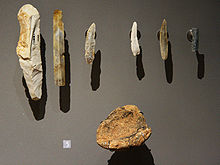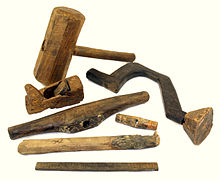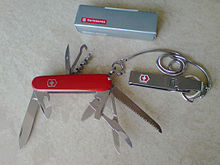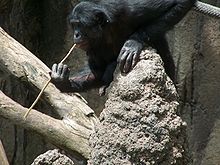- Tool
-
A tool is a device that can be used to produce an item or achieve a task, but that is not consumed in the process. Informally the word is also used to describe a procedure or process with a specific purpose. Tools that are used in particular fields or activities may have different designations such as Instrument, Utensil, Implement, Machine, or Apparatus.
Contents
History
Anthropologists believe that the use of tools was an important step in the evolution of mankind.[1] Humans evolved an opposable thumb — useful in holding tools — and increased dramatically in intelligence, which aided in the use of tools.[2] Because tools are used extensively by both humans and wild chimpanzees, it is widely assumed that the first routine use of tools took place prior to the divergence between the two species.[3] These early tools, however, were likely made of perishable materials such as sticks, or consisted of unmodified stones that cannot be distinguished from other stones as tools. The beginning of the Stone Age marks the era when hominins first began manufacturing stone tools, and evidence of these tools dates back at least 2.6 million years in Ethiopia.[4] One of the earliest distinguishable stone tool forms is the hand axe.
Tools are the most important items that the ancient humans used to climb to the top of the food chain; by inventing tools, they were able to accomplish tasks that human bodies could not, such as using a spear or bow and arrow to kill prey, since their teeth were not sharp enough to pierce many animals' skins.
The transition from stone to metal tools roughly coincided with the development of agriculture around the 4th millennium BC. Mechanical devices experienced a major expansion in their use in the Middle Ages with the systematic employment of new energy sources: water (waterwheels) and wind (windmills).
Machine tools occasioned a surge in producing new tools in the industrial revolution. Advocates of nanotechnology expect a similar surge as tools become microscopic in size.[5][6]
Functions
One can classify tools according to their basic functions:
- Cutting tools, such as the knife, scythe or sickle, are wedge-shaped implements that produce a shearing force along a narrow face. Ideally, the edge of the tool needs to be harder than the material being cut or else the blade will become dulled with repeated use. But even resilient tools will require periodic sharpening, which is the process of removing deformation wear from the edge. Other examples of cutting tools include gouges and drill bits.
- Moving tools move huge and tiny things. For example, concentrating-force tools: the hammer moves a nail, the maul moves a stake, or a whip moves flesh on a horse. These operate by applying physical compression to a surface. In the case of the screwdriver, the force is rotational and called torque. Writing implements deliver a fluid to a surface via compression to activate the ink cartridge. Also grabbing and twisting nuts and bolts with pliers, a glove, a wrench, etc. All these tools move items by some kind of force. Also trucks, rockets and airplanes move larger items and particle accelerators move very small items.
- Tools that enact chemical changes, including temperature and ignition, such as lighters and blowtorches.
- Guiding, measuring and perception tools include the ruler, glasses, set square, sensors, straightedge, theodolite, microscope, monitor, clock, phone, printer
- Shaping tools, such as moulds, jigs, trowels.
- Fastening tools, such as welders, rivet guns, nail guns, or glue guns.
- Information and data manipulation tools, such as computers, middleware, IDE, spreadsheets
Some tools may be combinations of other tools. An alarm-clock is for example a combination of a measuring tool (the clock) and a perception tool (the alarm). This enables the alarm-clock to be a tool that falls outside of all the categories mentioned above.
There is some debate on whether to consider protective gear items as tools, because they do not directly help perform work, just protect the worker like ordinary clothing. They do meet the general definition of tools and in many cases are necessary for the completion of the work.Personal protective equipment includes such items as gloves, safety glasses, ear defenders and biohazard suits.
Tool substitution
Often, by design or coincidence, a tool may share key functional attributes with one or more other tools. In this case, some tools can substitute for other tools, either as a make-shift solution or as a matter of practical efficiency. "One tool does it all" is a motto of some importance for workers who cannot practically carry every specialized tool to the location of every work task; such as a carpenter who does not necessarily work in a shop all day and needs to do jobs in a customers house. Tool substitution may be divided broadly into two classes: substitution "by-design", or "multi-purpose" use, and substitution as make-shift. Substitution "by-design" would be tools that are designed specifically to accomplish multiple tasks using only that one tool. Substitution as make-shift is when human ingenuity comes into play and a tool is used for its unintended purpose such as a mechanic using a long screw driver to separate a cars control arm from a ball joint instead of using a tuning fork. In many cases, the designed secondary functions of tools are not widely known. As an example of the former, many wood-cutting hand saws integrate a carpenter's square by incorporating a specially shaped handle that allows 90° and 45° angles to be marked by aligning the appropriate part of the handle with an edge and scribing along the back edge of the saw. The latter is illustrated by the saying "All tools can be used as hammers." Nearly all tools can be used to function as a hammer, even though very few tools are intentionally designed for it and even fewer work as well as the original.
Tools are also often used to substitute for many mechanical apparatuses, especially in older mechanical devices. In many cases a cheap tool could be used to occupy the place of a missing mechanical part. A window roller in a car could easily be replaced with a pair of vice grips or regular pliers. A transmission shifter or ignition switch would be able to be replaced with a screw-driver. Again, these would be considered tools that are being used for their unintended purposes, substitution as make-shift. Tools such as a Dremel would be considered the substitution "by-design", or "multi-purpose". This class of tools allows the use of one tool that has at least two different capabilities. "Multi-purpose" tools are basically multiple tools in one device/tool. Tools such as this are often power tools that come with many different attachments like a Dremel does, so you could say that a power drill is a "multi-purpose" tool because you can do more then just one thing with a power drill.
Multi-use tools
A Multi-tool is a hand tool that incorporates several tools into a single, portable device; the Swiss army knife represents one of the earliest examples. Other tools have a primary purpose but also incorporate other functionality - for example, lineman's pliers incorporate a gripper and cutter, and are often used as a hammer; and some hand saws incorporate a carpenter's square in the right-angle between the blade's dull edge and the saw's handle. This would also be the category in which the "multi-purpose" tools since they are also multiple tools in one (multi-use and multi-purpose can be used interchangeably). These types of tools were specifically made to catch the eye of many different craftsman who traveled to do their work. To these workers these types of tools were revolutionary because they were one tool or one device that could do several different things. With this knew revolution of tools the traveling craftsman would not have to carry so many tools with them to job sites, being that their space would be limited to the vehicle they were driving. The problem of having to deal with so many different tools was solved with the overtaking of multi-use tools.
Tool metaphors
A telephone is a communication tool that interfaces between two people engaged in conversation at one level. And between each user and the communication network at another. It is in the domain of media and communications technology that a counter-intuitive aspect of our relationships with our tools first began to gain popular recognition. Marshall McLuhan famously said "We shape our tools. And then our tools shape us." McLuhan was referring to the fact that our social practices co-evolve with our use of new tools and the refinements we make to existing tools.
In North American colloquialism, the word "tool" may be loosely used to describe an individual of low mental capacity (essentially, an "idiot") or someone who fails to realise that they are being taken advantage of by others.[7] This metaphor is drawn from the understanding that tools (as understood by most of society) are objects that are used for specific tasks.
Use by animals
Observation has confirmed that multiple species can use tools including monkeys, apes, several birds, and sea otters. Philosophers originally thought that only humans had the ability to make tools, until zoologists observed birds[8] and monkeys[9][10][11] making tools. Now the unique relationship of humans with tools is considered to be that we are the only species that uses tools to make other tools.[12]
See also
References
- ^ Sam Lilley, Men, Machines and History: The Story of Tools and Machines in Relation to Social Progress, 1948 Cobbett Press.
- ^ Primates and Their Adaptations, 2001, M.J. Farabee. Retrieved on November 6, 2006.
- ^ Whiten, A., J. Goodall, W. C. McGrew, T. Nishida, V. Reynolds, Y. Sugiyama, C. E. G. Tutin, R. W. Wrangham, and C. Boesch. 1999. Cultures in Chimpanzees. Nature 399:682-685. Panger, M. A., A. S. Brooks, B. G. Richmond, and B. Wood. 2002. Older than the Oldowan? Rethinking the emergence of hominin tool use. Evolutionary Anthropology: Issues, News, and Reviews 11:235-245.
- ^ Semaw, S., M. J. Rogers, J. Quade, P. R. Renne, R. F. Butler, M. Domínguez-Rodrigo, D. Stout, W. S. Hart, T. Pickering, and S. W. Simpson. 2003. 2.6-Million-year-old stone tools and associated bones from OGS-6 and OGS-7, Gona, Afar, Ethiopia. Journal of Human Evolution 45:169-177.
- ^ Nanotechnology: Big Potential In Tiny Particles, David Whelan. Retrieved on November 6, 2006
- ^ Will this Tiny Science Usher in the Next Industrial Revolution?, Katrina C. Arabe. Retrieved on November 6, 2006
- ^ "Urban Dictionary: Tool". http://www.urbandictionary.com/define.php?term=Tool. Retrieved 30 August 2011.
- ^ Selection of tool diameter by New Caledonian crows Corvus moneduloides, Jackie Chappell and Alex Kacelnik November 29, 2003
- ^ Calvin, William H. "The Throwing Madonna: Essays on the Brain". http://williamcalvin.com/bk2/bk2ch3.htm.
- ^ "Chimp Minds". Host: Alan Alda. Scientific American Frontiers. PBS. 02-09-2005. No. 4, season 15. Transcript.
- ^ "Rolling Hills Wildlife Adventure: Chimpanzee". http://www.rollinghillswildlife.com/animals/c/chimpanzee/.
- ^ Bjorklund, David F.; Bering, Jesse M. (5 June 1997). "Big brains, slow development and social complexity:The development and evolutionary origins of social cognition". In Cooper, Cary L.. International review of industrial and organizational psychology. Robertson, Ivan T.. John Wiley and Sons. p. 113. ISBN 9780471961116. http://books.google.com/books?id=Jd8d-i13CnUC&pg=PA113. Retrieved 10 July 2011.
Categories:- Manufacturing
- Tools
Wikimedia Foundation. 2010.






